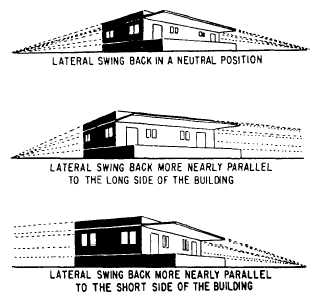camera. This can also occur when you attempt to
override an automatic camera.
Using a camera with TTL metering and placing
a color filter with a high-filter factor over the lens.
Wrong aperture setting when flash is used.
Shutter speed is not synchronized with camera
flash.
Aperture or shutter speed setting is knocked
while carrying the camera. Always check the
camera setting before taking a photograph.
Weak or incorrect battery in the light meter.
VIEW CAMERA
The view camera (fig. 4-20) is a flexible and useful
camera that, due to laziness, is frequently overlooked by
Navy imaging personnel. Through the use of rising or
falling fronts, swings, tilts, and shifts, you have
complete control over the composition of the subject.
View cameras are excellent for photographing
construction, large groups of people, landscapes, small
parts, damaged material, buildings, and many other
subjects, because distortion can be controlled or
corrected The camera has bellows that may be extended
to make it suitable for copy work and photographing
small objects. Most view cameras used in the Navy use
4x5 sheet film. View cameras are not suitable for sports
or uncontrolled action situations where a hand-held
camera is needed.
View cameras do not have viewfinders or range
finders. Viewing and focusing is done on ground glass.
The ground glass is located exactly the same distance
from the lens as the film; therefore, the image viewed
on the ground glass is the same that is recorded on the
film. View cameras have interchangeable lenses and
between-the-lens leaf shutters.
BASIC CONTROLS AND FUNCTIONS
All view cameras are basically the same. Generally,
all view cameras have the following standard parts:
Monorail or bed. Serves as the base or support to
hold all the other components.
Front lens standard. Permits the lens to be locked
into any position on the monorail. The front lens
standard also permits the lens to swing, slide, tilt, rise,
and fall.
Rear standard. The rear standard holds the film
holder and has swing, tilt, and slide controls.
Figure 4-21–Swing movement of front and rear standards.
Figure 4-22.–Correction for horizontal distortion.
Bellows. Connects the front and rear standards
and allows the two standards to move for focusing or to
accommodate various focal-length lenses.
Tripod head. Holds the monorail to the tripod.
L e n s .
Ground glass. Used for focusing, viewing, and
composing the image.
There are four basic movements or adjustments
used on a view camera. These basic movements perform
specific functions. The four basic movements are as
follows:
1. Horizontal or lateral swing. Both the front and
rear standards swing horizontally (fig. 4-21).
The swing back is used to correct distortion, or
perspective, in the horizontal plane. When you are
photographing subjects from an angle, horizontal lines
appear to converge at the distant side. To correct this
distortion, swing the camera back so it is more parallel
to the horizontal plane of the subject (fig. 4-22).
4-27





